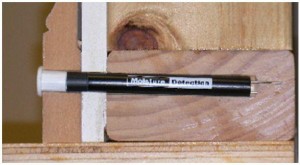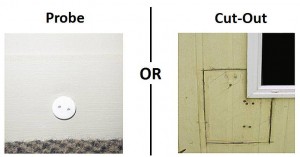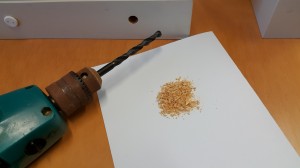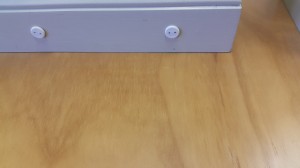Invasive Tests involve extracting small wood samples from wall framing of homes to determine definitively the presence of water, chemical treatment of the framing and the presence of decay fungi. The Mdu Probe invasive testing process causes no damage to the cladding, leaves no stigma and by being permanent probes makes it possible to check the moisture levels again and again.
 It is important to check moisture contents in both summer and winter to ensure a balanced view of what is performing and what isn’t before major decisions are made. It is useful to check moisture contents after repairs to test how effective they were. By taking regular moisture contents owners build up a useful record as evidence when they sell.
It is important to check moisture contents in both summer and winter to ensure a balanced view of what is performing and what isn’t before major decisions are made. It is useful to check moisture contents after repairs to test how effective they were. By taking regular moisture contents owners build up a useful record as evidence when they sell.
Some people suggest cut-outs. These provide the same information except the Mdu Probe is neat and tidy, does no damage to the cladding and being permanent can provide moisture content readings in the future to prove repairs were effective.

What is it?
Definitive test for moisture, decay and treatment levels.
How is it done?
Drilling holes through the skirting boards to extract framing samples and inserting an Mdu Probe to take moisture content readings.


What is it used for?
- Mainly for owners peace of mind.
- Works as a tool to check the condition of the building prior to considering repair options.
- Establishes proof of condition prior to selling.
- Helps buyers understand buildings condition.
- Provides evidence of what maintenance is required.
- Tool to determine compliance and to manage building condition.
What next?
If problems are found identifies how bad and how widespread they are so an appropriate repair can be justified.
What can it be used for?
Testing any wood framed building including Plaster and Fibre cement clad homes, decks, internal gutters, ground lines, almost any weathertight detail. Also useful testing reclads, weatherboard, brick and polystyrene clad homes.
Why?
Invasive testing defines whether damage already exists, or the presence of high moisture readings and/or low treatment which will allow decay to begin. Generally wet framing means defects exist in the cladding. Decayed framing means the framing has previously been wet. Determines if defects are isolated or systemic around the building. Provides evidence to define scopes. Mdu Probes allow ongoing monitoring to support current decisions and determine longer term maintenance and repairs.
What are the options?
One test into an area of suspicion
Technicians attendance, one invasive test and install one Mdu Probe. Email report.
Treatment tests
Attendance, collect minimum 3 wood samples and test for treatment. Provide a test report
Selling or buying or want to check a builders report
Basic invasive test plan for 6-10 invasive tests plus Mdu Probes left installed. Reports in table form. Basic comments by way of email if problems discovered.
Prove home is okay to purchasers
Install from 20-40 Mdu Probes each with invasive tests. Includes reports with plans and elevations (if provided)
Monitoring system
Invasive tests and Mdu Probes installed for basic 2 bedroom apartment – depends on number of walls and access to walls
Full house monitoring
This is the full package covering all the testings. We will provide a full house report and a review session to discuss the findings and options to make your house better.
NB: Auckland pricing only. Advise your location to see if we have an affiliate nearby.
How long does invasive testing take?
- Takes about 1-2 hours on site for up to 10 invasive tests
- Allow a full day for more extensive testing on larger homes.
- Generally we need 24 hours notice for smaller tests and 2 days notice for more extensive investigations.
- Our commitment is to provide immediate timber condition and moisture content readings followed by 24 hour chemical treatment testing. For larger homes allow 4 working days for results. Results released after payment.
When is the best time to do invasive tests?
Now is the short answer. The sooner you are informed the better.
The sooner leaks are discovered the sooner repairs can be arranged reducing further damage. It doesn’t matter what time of the year we do invasive tests as we are looking for timber treatment and timber condition first and foremost. If the framing is in good condition and treated, then it is moisture tolerant. Winter moisture content readings are important as these will be the ‘worst case scenario’. Making decisions based only on one or two cut-outs or based on wet winter moisture readings only can give a false understanding of the extent of problems and cause an over reaction prior to thinking alternatives. A good summer test may be useful but does not determine what the condition of framing is inside the walls. A good example would be to moisture test homes after a cyclone. They will be leaking and condemned. Come back in summer in a really dry period and it may be dry and perfect so no actions required. Decay can be widespread. Each home needs a tailored approach.

